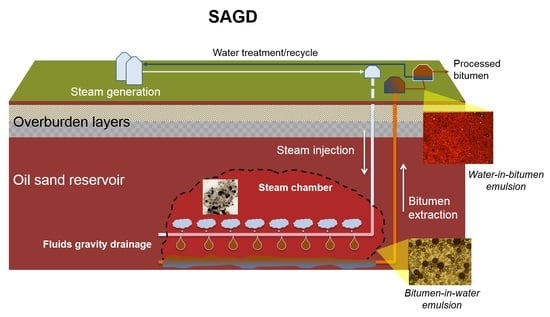Interfacial Chemistry in Steam-Based Thermal Recovery of Oil Sands Bitumen with Emphasis on Steam-Assisted Gravity Drainage and the Role of Chemical Additives
Abstract
1. Introduction
Thermal (In Situ) Recovery of Bitumen Production from Oil Sands
2. Oil Sands Structure and Composition
2.1. Asphaltenes
2.2. Organic Acids
2.3. Humic Acids
2.4. Clays and Other Fines
3. Nature of Steam-Based Thermal Recovery, Especially SAGD and Its Variants
3.1. Factors Affecting SAGD Performance
3.2. Oil Mobilization Mechanisms in SAGD Processes
- Solvency/dissolution (e.g., using oil-miscible solvents)
- Emulsification
- Displacement/detergency
- Foam formation
3.2.1. What Happens at the Liquid/Liquid Interface? Water-in-Oil Emulsions
3.2.2. What Happens at the Solid/Liquid Interface? Displacement/Detergency/Wetting
4. Chemical Additives in Steam-Based Thermal Recovery
- Detergency, including dissolution of asphaltenes, reducing oil/water interfacial tension, and modification of the wetting characteristics of the rock.
- Foam-assisted diversion of the steam to unswept areas of the reservoir.
4.1. The Emerging Role of Nanotechnology
4.2. Additive Requirements for SAGD
- Effective at reducing IFT
- Changes the reservoir wettability to water-wet
- Capable of being vaporized under SAGD operational conditions
- Thermally stable under SAGD conditions
- Able to stabilize oil-in-water emulsions
- Fully compatible with formation water
5. Composition of Produced Water
6. General Discussion and Conclusions
Acknowledgments
Conflicts of Interest
References
- Gates, I.D.; Wang, J.Y.J. Evolution of In Situ Oil Sands Recovery Technology in the Field: What Happened and what’s New? In SPE Heavy Oil Conference and Exhibition; Society of Petroleum Engineers: Kuwait City, Kuwait, 2011. [Google Scholar]
- Gates, I.D.; Chakrabarty, N. Optimization of Steam Assisted Gravity Drainage in McMurray Reservoir. J. Can. Pet. Technol. 2006, 45, 54–62. [Google Scholar] [CrossRef]
- Freitag, N.P.; Kristoff, B.J. Comparison of Carbon Dioxide and Methane as Additives at Steamflood Conditions. SPE J. 1998, 3, 14–18. [Google Scholar] [CrossRef]
- Speight, J.G. Enhanced Recovery Methods for Heavy Oil and Tar Sands, 1st ed.; Gulf Publishing Company: Houston, TX, USA, 2009; ISBN 978-1-933762-25-8. [Google Scholar]
- Holly, C.; Mader, M.; Soni, S.; Toor, J. Alberta Energy Technical Services Alberta Energy: Oil Sands Production Profile 2004–2014; Alberta Provincial Government: Edmonton, AB, Canada, 2016.
- Alberta Provincial Government Alberta Oil Sands Industry Quarterly Update: Summer 2017. Available online: http://www.albertacanada.com/business/statistics/oil-sands-quarterly.aspx (accessed on 25 March 2018).
- McCormack, M.E. Design of Steam-Hexane Injection Wells for Gravity Drainage Systems. J. Can. Pet. Technol. 2009, 48, 22–28. [Google Scholar] [CrossRef]
- Zajic, J.E.; Cooper, D.G.; Marshall, J.A.; Gerson, D.F. Microstructure of Athabasca Bituminous Sand by Freeze-Fracture Preparation and Transmission Electron Microscopy. Fuel 1981, 60, 619–623. [Google Scholar] [CrossRef]
- Takamura, K. Microscopic Structure of Athabasca Oil Sand. Can. J. Chem. Eng. 1982, 60, 538–545. [Google Scholar] [CrossRef]
- Hall, A.C.; Collins, S.H.; Melrose, J.C. Stability of Aqueous Wetting Films in Athabasca Tar Sands. Soc. Pet. Eng. J. 1983, 23, 249–258. [Google Scholar] [CrossRef]
- He, L.; Li, X.; Wu, G.; Lin, F.; Sui, H. Distribution of Saturates, Aromatics, Resins, and Asphaltenes Fractions in the Bituminous Layer of Athabasca Oil Sands. Energy Fuels 2013, 27, 4677–4683. [Google Scholar] [CrossRef]
- Montgomery, W.; Sephton, M.; Watson, J.; Zeng, H. The Effects of Minerals on Heavy Oil and Bitumen Chemistry When Recovered Using Steam-assisted Methods. In Proceedings of the SPE Heavy Oil Conference-Canada, Calgary, AB, Canada, 10–12 June 2014. [Google Scholar]
- Hongfu, F.; Yongjian, L.; Liying, Z.; Xiaofei, Z. The Study on Composition Changes of Heavy Oils during Steam Stimulation Processes. Fuel 2002, 81, 1733–1738. [Google Scholar] [CrossRef]
- Fan, H.-F.; Liu, Y.-J.; Zhong, L.-G. Studies on the Synergetic Effects of Mineral and Steam on the Composition Changes of Heavy Oils. Energy Fuels 2001, 15, 1475–1479. [Google Scholar] [CrossRef]
- Clark, P.; Hyne, J. Steam-Oil Chemical Reactions; Mechanisms for the Aquathermolysis of Heavy Oils. AOSTRA J. Res. 1984, 1, 15–20. [Google Scholar]
- Montgomery, W.; Court, R.W.; Rees, A.C.; Sephton, M.A. High Temperature Reactions of Water with Heavy Oil and Bitumen: Insights into Aquathermolysis Chemistry during Steam-Assisted Recovery. Fuel 2013, 113, 426–434. [Google Scholar] [CrossRef]
- Jia, N.; Zhao, H.; Yang, T.; Ibatullin, T.; Gao, J. Experimental Measurements of Bitumen−Water Aquathermolysis during a Steam-Injection Process. Energy Fuels 2016, 30, 5291–5299. [Google Scholar] [CrossRef]
- Mohammadmoradi, P.; Taheri, S.; Kantzas, A. Interfacial Areas in Athabasca Oil Sands. Energy Fuels 2017, 31, 8131–8145. [Google Scholar] [CrossRef]
- Wiehe, I.A.; Yarranton, H.W.; Akbarzadeh, K.; Rahimi, P.M.; Teclemariam, A. The Paradox of Asphaltene Precipitation with Normal Paraffins. Energy Fuels 2005, 19, 1261–1267. [Google Scholar] [CrossRef]
- Acevedo, S.; Ranaudo, M.A.; García, C.; Castillo, J.; Fernández, A. Adsorption of Asphaltenes at the Toluene−Silica Interface: A Kinetic Study. Energy Fuels 2003, 17, 257–261. [Google Scholar] [CrossRef]
- Montoya, T.; Coral, D.; Franco, C.A.; Nassar, N.N.; Cortés, F.B. A Novel Solid−Liquid Equilibrium Model for Describing the Adsorption of Associating Asphaltene Molecules onto Solid Surfaces Based on the “Chemical Theory”. Energy Fuels 2014, 28, 4963–4975. [Google Scholar] [CrossRef]
- Wang, S.; Liu, Q.; Tan, X.; Xu, C.; Gray, M.R. Adsorption of Asphaltenes on Kaolinite as an Irreversible Process. Colloids Surfaces A: Physicochem. Eng. Aspects 2016, 504, 280–286. [Google Scholar] [CrossRef]
- Tsiamis, A.; Taylor, S.E. Adsorption Behavior of Asphaltenes and Resins on Kaolinite. Energy Fuels 2017, 31, 10576–10587. [Google Scholar] [CrossRef]
- Rane, J.P.; Harbottle, D.; Pauchard, V.; Couzis, A.; Banerjee, S. Adsorption Kinetics of Asphaltenes at the Oil–Water Interface and Nanoaggregation in the Bulk. Langmuir 2012, 28, 9986–9995. [Google Scholar] [CrossRef] [PubMed]
- Acevedo, S.; Borges, B.; Quintero, F.; Piscitelly, V.; Gutierrez, L.B. Asphaltenes and Other Natural Surfactants from Cerro Negro Crude Oil. Stepwise Adsorption at the Water/Toluene Interface: Film Formation and Hydrophobic Effects. Energy Fuels 2005, 19, 1948–1953. [Google Scholar] [CrossRef]
- Kilpatrick, P.K. Water-in-Crude Oil Emulsion Stabilization: Review and Unanswered Questions. Energy Fuels 2012, 26, 4017–4026. [Google Scholar] [CrossRef]
- McLean, J.D.; Kilpatrick, P.K. Effects of Asphaltene Aggregation in Model Heptane-Toluene Mixtures on Stability of Water-in-Oil Emulsions. J. Colloid Interface Sci. 1997, 196, 23–34. [Google Scholar] [CrossRef] [PubMed]
- McLean, J.D.; Kilpatrick, P.K. Effects of Asphaltene Solvency on Stability of Water-in-Crude-Oil Emulsions. J. Colloid Interface Sci. 1997, 189, 242–253. [Google Scholar] [CrossRef]
- Brient, J.A.; Wessner, P.J.; Doyle, M.N. Naphthenic Acids. Kirk-Othmer Encycl. Chem. Technol. 1995. [Google Scholar] [CrossRef]
- Headley, J.V.; McMartin, D.W. A Review of the Occurrence and Fate of Naphthenic Acids in Aquatic Environments. J. Environ. Sci. Health Part A 2004, 39, 1989–2010. [Google Scholar] [CrossRef]
- Varadaraj, R.; Brons, C. Molecular Origins of Heavy Crude Oil Interfacial Activity. Part 2: Fundamental Interfacial Properties of Model Naphthenic Acids and Naphthenic Acids Separated from Heavy Crude Oils. Energy Fuels 2007, 21, 199–204. [Google Scholar] [CrossRef]
- Smith, D.F.; Schaub, T.M.; Rahimi, P.; Teclemariam, A.; Rodgers, R.P.; Marshall, A.G. Self-Association of Organic Acids in Petroleum and Canadian Bitumen Characterized by Low- and High-Resolution Mass Spectrometry. Energy Fuels 2007, 21, 1309–1316. [Google Scholar] [CrossRef]
- Varadaraj, R.; Brons, C. Molecular Origins of Heavy Oil Interfacial Activity. Part 1: Fundamental Interfacial Properties of Asphaltenes Derived from Heavy Crude Oils and Their Correlation to Chemical Composition. Energy Fuels 2007, 21, 195–198. [Google Scholar] [CrossRef]
- Wang, X.; Pensini, E.; Liang, Y.; Xu, Z.; Chandra, M.S.; Andersen, S.I.; Abdallah, W.; Buiting, J.J. Fatty Acid-Asphaltene Interactions at Oil/Water Interface. Colloids Surfaces A: Physicochem. Eng. Aspects 2017, 513, 168–177. [Google Scholar] [CrossRef]
- Wu, X. Investigating the Stability Mechanism of Water-in-Diluted Bitumen Emulsions through Isolation and Characterization of the Stabilizing Materials at the Interface. Energy Fuels 2003, 17, 179–190. [Google Scholar] [CrossRef]
- Stanford, L.A.; Rodgers, R.P.; Marshall, A.G.; Czarnecki, J.; Wu, X.A.; Taylor, S. Detailed Elemental Compositions of Emulsion Interfacial Material versus Parent Oil for Nine Geographically Distinct Light, Medium, and Heavy Crude Oils, Detected by Negative- and Positive-Ion Electrospray Ionization Fourier Transform Ion Cyclotron Resonance Mass Spectrometry. Energy Fuels 2007, 21, 973–981. [Google Scholar] [CrossRef]
- Collins, S.H.; Melrose, J.C. Adsorption of Asphaltenes and Water on Reservoir Rock Minerals. In Proceedings of the SPE Oilfield and Geothermal Chemistry Symposium, Denver, CO, USA, 1–3 June 1983; Society of Petroleum Engineers: Denver, CO, USA. [Google Scholar]
- Gonzalez, G.; Travalloni-Louvisse, A.M. Adsorption of Asphaltenes and Its Effect on Oil Production. SPE Prod. Facil. 1993, 8, 91–96. [Google Scholar] [CrossRef]
- Keleşoğlu, S.; Volden, S.; Kes, M.; Sjöblom, J. Adsorption of Naphthenic Acids onto Mineral Surfaces Studied by Quartz Crystal Microbalance with Dissipation Monitoring (QCM-D). Energy Fuels 2012, 26, 5060–5068. [Google Scholar] [CrossRef]
- Madsen, L.; Ida, L. Adsorption of Carboxylic Acids on Reservoir Minerals from Organic and Aqueous Phase. SPE Res. Eval. Eng. 1998, 1, 47–51. [Google Scholar] [CrossRef]
- Osacky, M.; Geramian, M.; Ivey, D.G.; Liu, Q.; Etsell, T.H. Mineralogical and Chemical Composition of Petrologic End Members of Alberta Oil Sands. Fuel 2013, 113, 148–157. [Google Scholar] [CrossRef]
- Sparks, B.D.; Kotlyar, L.S.; O’Carroll, J.B.; Chung, K.H. Athabasca Oil Sands: Effect of Organic Coated Solids on Bitumen Recovery and Quality. J. Pet. Sci. Eng. 2003, 39, 417–430. [Google Scholar] [CrossRef]
- Kotlyar, L.S.; Sparks, B.D.; Woods, J.R.; Chung, K.H. Solids Associated with the Asphaltene Fraction of Oil Sands Bitumen. Energy Fuels 1999, 13, 346–350. [Google Scholar] [CrossRef]
- Guttierez, L.; Pawlik, M. Influence of Humic Acids on Oil Sand Processing. Part I: Detection and Quantification of Humic Acids in Oil Sand Ores and Their Effect on Bitumen Wettability. Int. J. Min. Proc. 2014, 126, 117–125. [Google Scholar] [CrossRef]
- Guttierez, L.; Pawlik, M. Influence of Humic Acids on Oil Sand Processing. Part II: Relationship between Bitumen Extraction, Humic Acids Concentration and Power Draw Measurements on Oil Sand Slurries. Int. J. Min. Proc. 2014, 126, 126–135. [Google Scholar] [CrossRef]
- Kotlyar, L.S.; Ripmeester, J.A.; Sparks, B.D.; Montgomery, D.S. Characterization of Organic-Rich Solids Fractions Isolated from Athabasca Oil Sand Using a Cold Water Agitation Test. Fuel 1988, 67, 221–226. [Google Scholar] [CrossRef][Green Version]
- Margeson, J.; Hornof, V. Characterization of the Humic-Clay Complex and Its Influence on Bitumen Displacement from Athabasca Oil Sand. J. Can. Pet. Technol. 1989, 28, 57–62. [Google Scholar] [CrossRef]
- Majid, A.; Ripmeester, J.A. Isolation and Characterization of Humic Acids from Alberta Oil Sands and Related Materials. Fuel 1990, 69, 1527–1536. [Google Scholar] [CrossRef][Green Version]
- Kupai, M.M.; Yang, F.; Harbottle, D.; Moran, K.; Masliyah, J.; Xu, Z. Characterising Rag-Forming Solids. Can. J. Chem. Eng. 2013, 91, 1395–1401. [Google Scholar] [CrossRef]
- Jiang, T.; Hirasaki, G.J.; Miller, C.A.; Ng, S. Effects of Clay Wettability and Process Variables on Separation of Diluted Bitumen Emulsion. Energy Fuels 2011, 25, 545–554. [Google Scholar] [CrossRef]
- Marhaba, T. Fluorescence Technique for Rapid Identification of DOM Fractions. J. Environ. Eng. 2000, 126, 145–152. [Google Scholar] [CrossRef]
- Thakurta, S.G.; Maiti, A.; Pernitsky, D.J.; Bhattacharjee, S. Dissolved Organic Matter in Steam Assisted Gravity Drainage Boiler Blow-Down Water. Energy Fuels 2013, 27, 3883–3890. [Google Scholar] [CrossRef]
- Pillai, R.G.; Yang, N.; Thi, S.; Fatema, J.; Sadrzadeh, M.; Pernitsky, D. Characterization and Comparison of Dissolved Organic Matter Signatures in Steam-Assisted Gravity Drainage Process Water Samples from Athabasca Oil Sands. Energy Fuels 2017, 31, 8363–8373. [Google Scholar] [CrossRef]
- Chung, T.; Bae, W.; Lee, J.; Lee, W.; Jung, B. A Review of Practical Experience and Management of the SAGD Process for Oil Sands Development. Energy Sources Part Recovery Util. Environ. Eff. 2011, 34, 219–226. [Google Scholar] [CrossRef]
- Butler, R.M.; Yee, C.T. Progress in the In Situ Recovery of Heavy Oils and Bitumen. J. Can. Pet. Technol. 2002, 41. [Google Scholar] [CrossRef]
- Jiang, Q.; Thornton, B.; Houston, J.R.; Spence, S. Review of Thermal Recovery Technologies for the Clearwater and Lower Grand Rapids Formations in the Cold Lake Area in Alberta. J. Can. Pet. Technol. 2010, 49, 2–13. [Google Scholar] [CrossRef]
- Al Bahlani, A.M.; Babadagli, T. A Critical Review of the Status of SAGD: Where Are We and What Is Next? In Proceedings of the SPE Western Regional and Pacific Section AAPG Joint Meeting, Bakersfield, CA, USA, 29 March–4 April 2008; Society of Petroleum Engineers: Bakersfield, CA, USA. [Google Scholar]
- Gotawala, D.R.; Gates, I.D. Steam Fingering at the Edge of a Steam Chamber in a Heavy Oil Reservoir. Can. J. Chem. Eng. 2008, 86, 1011–1022. [Google Scholar] [CrossRef]
- Upreti, S.R.; Lohi, A.; Kapadia, R.A.; El-Haj, R. Vapor Extraction of Heavy Oil and Bitumen: A Review. Energy Fuels 2007, 21, 1562–1574. [Google Scholar] [CrossRef]
- Chen, Q. Assessing and Improving Steam-Assisted Gravity Drainage: Reservoir Heterogeneities, Hydraulic Fractures, and Mobility Control Foams. Ph.D. Thesis, Stanford University, Stanford, CA, USA, 2009. [Google Scholar]
- Acosta, E. Achieving Sustainable, Optimal SAGD Operations. J. Pet. Technol. 2010, 62, 24–28. [Google Scholar] [CrossRef]
- Thimm, H.F. Understanding the Generation of Dissolved Silica in Thermal Projects: Theoretical Progress. J. Can. Pet. Technol. 2008, 47, 22–25. [Google Scholar] [CrossRef]
- Bowman, R.W.; Gramms, L.C.; Craycraft, R.R. High-Silica Waters in Steamflood Operations. SPE Prod. Facil. 2000, 15, 123–125. [Google Scholar] [CrossRef]
- Barillas, J.L.M.; Dutra, T.V.; Mata, W. Reservoir and Operational Parameters Influence in SAGD Process. J. Pet. Sci. Eng. 2006, 54, 34–42. [Google Scholar] [CrossRef]
- Butler, R.M.; McNab, G.S.; Lo, H.Y. Theoretical Studies on the Gravity Drainage of Heavy Oil During In-Situ Steam Heating. Can. J. Chem. Eng. 1981, 59, 455–460. [Google Scholar] [CrossRef]
- Krieger, I.M.; Dougherty, T.J. A Mechanism for Non-Newtonian Flow in Suspensions of Rigid Spheres. Trans. Soc. Rheol. 1959, 3, 137–152. [Google Scholar] [CrossRef]
- Mueller, S.; Llewellin, E.W.; Mader, H.M. The Rheology of Suspensions of Solid Particles. Proc. R. Soc. Math. Phys. Eng. Sci. 2010, 466, 1201–1228. [Google Scholar] [CrossRef]
- Bennion, D.B.; Chan, M.Y.S.; Sarioglu, G.; Courtnage, D.; Wansleeben, J.; Hirata, T. The In-Situ Formation of Bitumen-Water-Stable Emulsions in Porous Media during Thermal Stimulation. In Proceedings of the SPE International Thermal Operations Symposium, Bakersfield, CA, USA, 8–10 February 1993; Society of Petroleum Engineers: Bakersfield, CA, USA. [Google Scholar]
- Sarbar, M.; Livesey, D.B.; Wes, W.; Flock, D.L. The Effect of Chemical Additives on the Stability of Oil-in-Water Emulsion Flow through Porous Media. In Proceedings of the 38th Annual CIM Petroleum Society Technical Meeting, Calgary, AB, Canada, 7–10 June 1987. [Google Scholar]
- Bosch, R.; Axcell, E.; Little, V.; Cleary, R.; Wang, S.; Gabel, R.; Moreland, B. A Novel Approach for Resolving Reverse Emulsions in SAGD Production Systems. Can. J. Chem. Eng. 2004, 82, 836–839. [Google Scholar] [CrossRef]
- Chung, K.; Butler, A. In Situ Emulsification by the Condensation of Steam in Contact with Bitumen. J. Can. Pet. Technol. 1989, 28, 48–55. [Google Scholar] [CrossRef]
- Chen, T.; Yuan, J.Y.; Serres, A.J.; Rancier, D.G. Emulsification of Water into Bitumen in Co-injection Experiments. J. Can. Pet. Technol. 1999, 38. [Google Scholar] [CrossRef]
- Bryan, J.; Wang, J.; Kantzas, A. Measurement of Emulsion Flow in Porous Media: Improvements in Heavy Oil Recovery. J. Phys. Conf. Ser. 2009, 147, 012058. [Google Scholar] [CrossRef]
- Vittoratos, E. Flow Regimes during Cyclic Steam Stimulation at Cold Lake. J. Can. Pet. Technol. 1991, 30, 82–86. [Google Scholar] [CrossRef]
- Wang, D.; Lin, M.; Dong, Z.; Li, L.; Jin, S.; Pan, D.; Yang, Z. Mechanism of High Stability of Water-in-Oil Emulsions at High Temperature. Energy Fuels 2016, 30, 1947–1957. [Google Scholar] [CrossRef]
- Glandt, C.A.; Chapman, W.G. Effect of Water Dissolution on Oil Viscosity. SPE Reserv. Eng. 1995, 10, 59–64. [Google Scholar] [CrossRef]
- Zirrahi, M.; Hassanzadeh, H.; Abedi, J. Experimental and Modeling Studies of MacKay River Bitumen and Water. J. Pet. Sci. Eng. 2017, 151, 305–310. [Google Scholar] [CrossRef]
- Drelich, J.; Leliński, D.; Miller, J.D. Bitumen Spreading and Formation of Thin Bitumen Films at a Water Surface. Colloids Surfaces A: Physicochem. Eng. Asp. 1996, 116, 211–223. [Google Scholar] [CrossRef]
- Gonzalez, V.; Taylor, S.E. Physical and Chemical Aspects of “Precursor Films” Spreading on Water from Natural Bitumen. J. Petrol. Sci. Eng. Submitted.
- Azom, P.; Srinivasan, S. Mechanistic Modeling of Emulsion Formation and Heat Transfer during the Steam-Assisted Gravity Drainage (SAGD) Process. In Proceedings of the SPE Annual Technical Conference and Exhibition, New Orleans, LA, USA, 4–7 October 2009; Society of Petroleum Engineers: New Orleans, LA, USA. [Google Scholar]
- Sasaki, K.; Akibayashi, S.; Yazawa, N.; Kaneko, F. Microscopic Visualization with High Resolution Optical-Fiber Scope at Steam Chamber Interface on Initial Stage of SAGD Process. In Proceedings of the SPE/DOE Improved Oil Recovery Symposium, Tulsa, OK, USA, 13–17 April 2002; Society of Petroleum Engineers: Tulsa, OK, USA. [Google Scholar]
- Zekri, A.; Shedid, S.; Hassan, A. A Novel Technique for Treating Asphaltene Deposition using Laser Technology. In Proceedings of the SPE Permian Basin Oil and Gas Recovery Conference, Midland, TX, USA, 15–17 May 2001; Society of Petroleum Engineers: Midland, TX, USA. [Google Scholar]
- Al-Hadhrami, H.; Blunt, M. Thermally Induced Wettability Alteration to Improve Oil Recovery in Fractured Reservoirs. SPE Reservoir Eval. Eng. 2001, 4, 179–186. [Google Scholar] [CrossRef]
- Rao, D. Wettability Effects in Thermal Recovery Operations. SPE Res. Eval. Eng. 1999, 2, 420–430. [Google Scholar] [CrossRef]
- Isaacs, E.; Nasr, T.; Babchin, A. Enhanced Oil Recovery by Altering Wettability. U.S. Patent 6,186,232, 13 February 2001. [Google Scholar]
- Yuan, J.Y.; Law, D.H.S.; Nasr, T.N. Benefit of Wettability Change near the Production Well in SAGD. In Proceedings of the Canadian International Petroleum Conference, Tulsa, OK, USA, 11–13 June 2002; Petroleum Society of Canada: Tulsa, OK, USA. [Google Scholar]
- Flury, C.; Afacan, A.; Tamiz Bakhtiari, M.; Sjoblom, J.; Xu, Z. Effect of Caustic Type on Bitumen Extraction from Canadian Oil Sands. Energy Fuels 2014, 28, 431–438. [Google Scholar] [CrossRef]
- Castanier, L.M.; Brigham, W.E. An Evaluation of Field Projects of Steam with Additives. SPE Res. Eng. 1991, 6, 62–68. [Google Scholar] [CrossRef]
- Shedid, S.A.; El Abbas, A.A. Experimental Study of Surfactant Alkaline Steam Flood through Vertical Wells. In Proceedings of the SPE/AAPG Western Regional Meeting, Long Beach, CA, USA, 19–22 June 2000; Society of Petroleum Engineers: Long Beach, CA, USA. [Google Scholar]
- El Abbas, A.; Shedid, S. Experimental Investigation of the Feasibility of Steam/Chemical Steam Flooding Processes through Horizontal Wells. In Proceedings of the SPE Asia Pacific Oil and Gas Conference and Exhibition, Jakarta, Indonesia, 17–19 April 2001; Society of Petroleum Engineers: Jakarta, Indonesia. [Google Scholar]
- Yamazaki, T.; Matsuzawa, N.; Abdelkarim, O.; Ono, Y. Recovery of Bitumen from Oil Sand by Steam with Chemicals. J. Pet. Sci. Eng. 1989, 3, 147–159. [Google Scholar] [CrossRef]
- Madhavan, R.M.; Mamora, D.D. Experimental Investigation of Caustic Steam Injection for Heavy Oils. In Proceedings of the SPE Improved Oil Recovery Symposium, Tulsa, OK, USA, 24–28 April 2010; Society of Petroleum Engineers: Tulsa, OK, USA. [Google Scholar]
- Brown, A.; Carlin, J.; Fontaine, M.; Haynes, S. Method for Recovery of Hydrocarbons Utilizing Steam Injection. U.S. Patent 3,732,926, 15 May 1973. [Google Scholar]
- Katritzky, A.R.; Allin, S.M.; Siskin, M. Aquathermolysis: Reactions of Organic Compounds with Superheated Water. Acc. Chem. Res. 1996, 29, 399–406. [Google Scholar] [CrossRef]
- Gall, J.W. Steam Diversion by Surfactants. In SPE Annual Technical Conference and Exhibition; Society of Petroleum Engineers: Las Vegas, NV, USA, 1985. [Google Scholar]
- Dilgren, R.E.; Owens, K.B. Olefin Sulfonate-Improved Steam Foam Drive. U.S. Patent 4,393,937, 19 July 1983. [Google Scholar]
- Maini, B.B.; Ma, V. Laboratory Evaluation of Foaming Agents for High-Temperature Applications: I. Measurements of Foam Stability at Elevated Temperatures and Pressures. J. Can. Pet. Technol. 1986, 25. [Google Scholar] [CrossRef]
- Novosad, J.; Maini, B.B.; Huang, A. Retention of Foam-Forming Surfactants at Elevated Temperatures. J. Can. Pet. Technol. 1986, 25. [Google Scholar] [CrossRef]
- Cheraghian, G.; Hendraningrat, L. A Review on Applications of Nanotechnology in the Enhanced Oil Recovery. Part A: Effects of Nanoparticles on Interfacial Tension. Int. Nano Lett. 2016, 6, 129–138. [Google Scholar] [CrossRef]
- Cheraghian, G.; Hendraningrat, L. A Review on Applications of Nanotechnology in the Enhanced Oil Recovery. Part B: Effects of Nanoparticles on Flooding. Int. Nano Lett. 2016, 6, 1–10. [Google Scholar] [CrossRef]
- Negin, C.; Ali, S.; Xie, Q. Application of Nanotechnology for Enhancing Oil Recovery—A Review. Petroleum 2016, 2, 324–333. [Google Scholar] [CrossRef]
- Hashemi, R.; Nassar, N.N.; Almao, P.P. Nanoparticle Technology for Heavy Oil In-Situ Upgrading and Recovery Enhancement: Opportunities and Challenges. Appl. Energy 2014, 133, 374–387. [Google Scholar] [CrossRef]
- Wasan, D.T.; Nikolov, A.D. Spreading of Nanofluids on Solids. Nature 2003, 423, 156–159. [Google Scholar] [CrossRef] [PubMed]
- Wasan, D.; Nikolov, A.; Kondiparty, K. The Wetting and Spreading of Nanofluids on Solids: Role of the Structural Disjoining Pressure. Curr. Opin. Colloid Interface Sci. 2011, 16, 344–349. [Google Scholar] [CrossRef]
- Lim, S.; Horiuchi, H.; Nikolov, A.D.; Wasan, D. Nanofluids Alter the Surface Wettability of Solids. Langmuir 2015, 31, 5827–5835. [Google Scholar] [CrossRef] [PubMed]
- Wu, S.; Nikolov, A.; Wasan, D. Cleansing Dynamics of Oily Soil using Nanofluids. J. Colloid Interface Sci. 2013, 396, 293–306. [Google Scholar] [CrossRef] [PubMed]
- Ehtesabi, H.; Ahadian, M.M.; Taghikhani, V.; Ghazanfari, M.H. Enhanced Heavy Oil Recovery in Sandstone Cores Using TiO2 Nanofluids. Energy Fuels 2013, 28, 423–430. [Google Scholar] [CrossRef]
- Al-Anssari, S.; Arif, M.; Wang, S.; Barifcani, A.; Lebedev, M.; Iglauer, S. Wettability of Nanofluid-Modified Oil-Wet Calcite at Reservoir Conditions. Fuel 2018, 211, 405–414. [Google Scholar] [CrossRef]
- Huibers, B.M.J.; Pales, A.R.; Bai, L.; Li, C.; Mu, L.; Ladner, D.; Daigle, H.; Darnault, C.J.G. Wettability Alteration of Sandstones by Silica Nanoparticle Dispersions in Light and Heavy Crude Oil. J. Nanopart. Res. 2017, 19, 323. [Google Scholar] [CrossRef]
- Wei, Y.; Babadagli, T. Selection of Proper Chemicals to Improve the Performance of Steam Based Thermal Applications in Sands and Carbonates. In Proceedings of the SPE Latin America and Caribbean Heavy and Extra Heavy Oil Conference, Lima, Peru, 19–20 October 2016; Society of Petroleum Engineers: Lima, Peru. [Google Scholar]
- Zhang, H.; Nikolov, A.; Wasan, D. Enhanced Oil Recovery (EOR) Using Nanoparticle Dispersions: Underlying Mechanism and Imbibition Experiments. Energy Fuels 2014, 28, 3002–3009. [Google Scholar] [CrossRef]
- Sun, X.; Zhang, Y.; Chen, G.; Gai, Z. Application of Nanoparticles in Enhanced Oil Recovery: A Critical Review of Recent Progress. Energies 2017, 10, 345. [Google Scholar] [CrossRef]
- Shokrlu, Y.H.; Babadagli, T. In-Situ Upgrading of Heavy Oil/Bitumen during Steam Injection by Use of Metal Nanoparticles: A Study on In-Situ Catalysis and Catalyst Transportation. SPE Res. Eval. Eng. 2013, 16, 333–344. [Google Scholar] [CrossRef]
- Shokrlu, Y.H.; Babadagli, T. Viscosity Reduction of Heavy Oil/Bitumen using Micro- and Nano-Metal Particles during Aqueous and Non-Aqueous Thermal Applications. J. Petrol. Sci. Eng. 2014, 119, 210–220. [Google Scholar] [CrossRef]
- Guo, K.; Li, H.; Yu, Z. Metallic Nanoparticles for Enhanced Heavy Oil Recovery: Promises and Challenges. Energy Procedia 2015, 75, 2068–2073. [Google Scholar] [CrossRef]
- Hashemi, R.; Nassar, N.N.; Almao, P.P. Enhanced Heavy Oil Recovery by in Situ Prepared Ultradispersed Multimetallic Nanoparticles: A Study of Hot Fluid Flooding for Athabasca Bitumen Recovery. Energy Fuels 2013, 27, 2194–2201. [Google Scholar] [CrossRef]
- Hashemi, R.; Nassar, N.N.; Almao, P.P. In Situ Upgrading of Athabasca Bitumen Using Multimetallic Ultradispersed Nanocatalysts in an Oil Sands Packed-Bed Column: Part 1. Produced Liquid Quality Enhancement. Energy Fuels 2014, 28, 1338–1350. [Google Scholar] [CrossRef]
- Blair, C.M. Method of Recovering Petroleum from a Subterranean Reservoir Incorporating Resinous Polyalkylene Oxide Adducts. U.S. Patent 4,260,019, 7 April 1981. [Google Scholar]
- Taylor, S.E. Resolving Crude Oil Emulsions. Chem. Ind. 1992, 20, 770–773. [Google Scholar]
- Blair, C.M.; Scribner, R.E.; Stout, C.A. Persistent Action of Thin-Film Spreading Agents used in Cyclic Steam Stimulation. In Proceedings of the SPE California Regional Meeting, Ventura, CA, USA, 23–25 March 1983; Society of Petroleum Engineers: Ventura, CA, USA. [Google Scholar]
- Zeidani, K.; Gupta, S. Hydrocarbon Recovery from Bituminous Sands with Injection of Surfactant Vapour. U.S. Patent Application 2013/0081808, 4 April 2013. [Google Scholar]
- Zeidani, K.; Gupta, S.C. Surfactant-Steam Process: An Innovative Enhanced Heavy Oil Recovery Method for Thermal Applications. In Proceedings of the SPE Heavy Oil Conference Canada, Calgary, AB, Canada, 11–13 June 2013; Society of Petroleum Engineers: Calgary, AB, Canada. [Google Scholar]
- Srivastava, P.; Debord, J.; Sadetsky, V.; Stefan, B.J.; Orr, B.W. Laboratory Evaluation of a Chemical Additive to Increase Production in Steam Assisted Gravity Drainage (SAGD). In Proceedings of the SPE Improved Oil Recovery Symposium, Tulsa, OK, USA, 24–28 April 2010; Society of Petroleum Engineers: Tulsa, OK, USA. [Google Scholar]
- Srivastava, P.; Sadetsky, V.; Debord, J.; Stefan, B.; Orr, B. Development of a Steam-Additive Technology to Enhance Thermal Recovery of Heavy Oil. In Proceedings of the SPE Annual Technical Conference, Florence, Italy, 19–22 September 2010; Society of Petroleum Engineers: Florence, Italy. [Google Scholar]
- Hart, P.R.; Stefan, B.J.; Srivastava, P.; Debord, J.D. Method for Enhancing Heavy Hydrocarbon Recovery. U.S. Patent 7,938,183, 11 May 2011. [Google Scholar]
- Campos, R.E.; Hernandez, J.A. In-Situ Reduction of Oil Viscosity during Steam Injection Process in EOR. U.S. Patent 5,314,615, 24 May 1994. [Google Scholar]
- Koebel, M.; Strutz, E.O. Thermal and Hydrolytic Decomposition of Urea for Automotive Selective Catalytic Reduction Systems: Thermochemical and Practical Aspects. Ind. Eng. Chem. Res. 2003, 42, 2093–2100. [Google Scholar] [CrossRef]
- Rees, A.C.; Coulter, C.; Engelman, R.; Guerrero-Aconcha, U.; Taylor, S.E.; Peats, A.; Zeng, H. Systems and Methods for Accelerating Production of Viscous Hydrocarbons in a Subterranean Reservoir with Thermally Activated Chemical Agents. U.S. Patent Application 2014/0262241, 18 September 2014. [Google Scholar]
- Bruns, F.; Babadagli, T. Recovery Improvement of Gravity Driven Steam Applications Using New Generation Chemical Additives. In Proceedings of the SPE Western Regional Meeting, Bakersfield, CA, USA, 23–27 April 2017; Society of Petroleum Engineers: Bakersfield, CA, USA. [Google Scholar]
- Liu, Q.; Dong, M.; Yue, X.; Hou, J. Synergy of Alkali and Surfactant in Emulsification of Heavy Oil in Brine. Colloids Surfaces A Physicochem. Eng. Asp. 2006, 273, 219–228. [Google Scholar] [CrossRef]
- Dong, M.; Ma, S.; Liu, Q. Enhanced Heavy Oil Recovery through Interfacial Instability: A Study of Chemical Flooding for Brintnell Heavy Oil. Fuel 2009, 88, 1049–1056. [Google Scholar] [CrossRef]
- Pei, H.; Zhang, G.; Ge, J.; Jin, L.; Ding, L. Study on the Variation of Dynamic Interfacial Tension in the Process of Alkaline Flooding for Heavy Oil. Fuel 2013, 104, 372–378. [Google Scholar] [CrossRef]
- Tang, M.; Zhang, G.; Ge, J.; Jiang, P.; Liu, Q.; Pei, H.; Chen, L. Investigation into the Mechanisms of Heavy Oil Recovery by Novel Alkaline Flooding. Colloids Surfaces A Physicochem. Eng. Asp. 2006, 421, 91–100. [Google Scholar] [CrossRef]
- De Haas, T.W.; Fadaei, H.; Guerrero, U.; Sinton, D. Steam-on-a-Chip for Oil Recovery: The Role of Alkaline Additives in Steam Assisted Gravity Drainage. Lab. Chip 2013, 13, 3832. [Google Scholar] [CrossRef] [PubMed]
- Gonzalez, V.; Jones, M.; Taylor, S.E. Spin−Spin Relaxation Time Investigation of Oil/Brine/Sand Systems. Kinetics, Effects of Salinity, and Implications for Wettability and Bitumen Recovery. Energy Fuels 2016, 30, 844–853. [Google Scholar] [CrossRef]
- Chen, Q.; Gerritsen, M.G.; Kovscek, A.R. Improving Steam-Assisted Gravity Drainage Using Mobility Control Foams: Foam Assisted-SAGD (FA-SAGD). In Proceedings of the SPE Improved Oil Recovery Symposium, Tulsa, OK, USA, 24–28 April 2010; Society of Petroleum Engineers: Tulsa, OK, USA. [Google Scholar]
- Maiti, A.; Sadrezadeh, M.; Thakurta, S.G.; Pernitsky, D.J.; Bhattacharjee, S. Characterization of Boiler Blowdown Water from Steam-Assisted Gravity Drainage and Silica−Organic Coprecipitation during Acidification and Ultrafiltration. Energy Fuels 2012, 26, 5604–5612. [Google Scholar] [CrossRef]
- Clemente, J.S.; Fedorak, P.M. A Review of the Occurrence, Analyses, Toxicity, and Biodegradation of Naphthenic Acids. Chemosphere 2005, 60, 585–600. [Google Scholar] [CrossRef] [PubMed]
- Kawaguchi, H.; Li, Z.; Masuda, Y.; Sato, K.; Nakagawa, H. Dissolved Organic Compounds in Reused Process Water for Steam-Assisted Gravity Drainage Oil Sands Extraction. Water Res. 2012, 46, 5566–5574. [Google Scholar] [CrossRef] [PubMed]
- Xu, Y.; Dong, B.; Dai, X. Effect of the Silica-Rich, Oilfield-Produced Water with Different Degrees of Softening on Characteristics of Scales in Steam-Injection Boiler. Desalination 2015, 361, 38–45. [Google Scholar] [CrossRef]
- Angle, C.W.; Dabros, T.; Hamza, H.A. Demulsifier Effectiveness in Treating Heavy Oil Emulsion in the Presence of Fine Sands in the Production Fluids. Energy Fuels 2007, 21, 912–919. [Google Scholar] [CrossRef]
- Petersen, M.A.; Grade, H. Analysis of Steam Assisted Gravity Drainage Produced Water using Two-Dimensional Gas Chromatography with Time-of-Flight Mass Spectrometry. Ind. Eng. Chem. Res. 2011, 50, 12217–12224. [Google Scholar] [CrossRef]
- Lewis, A.T.; Tekavec, T.N.; Jarvis, J.M.; Juyal, P.; McKenna, A.M.; Yen, A.T.; Rodgers, R.P. Evaluation of the Extraction Method and Characterization of Water-Soluble Organics from Produced Water by Fourier Transform Ion Cyclotron Resonance Mass Spectrometry. Energy Fuels 2013, 27, 1846–1855. [Google Scholar] [CrossRef]
- Razi, M.; Sinha, S.; Waghmare, P.R.; Das, S.; Thundat, T. Effect of Steam-Assisted Gravity Drainage Produced Water Properties on Oil/Water Transient Interfacial Tension. Energy Fuels 2016, 30, 10714–10720. [Google Scholar] [CrossRef]
- Sikes, C.S.; Sikes, D.; Hochwalt, M.A. Flotation and Separation of Flocculated Oils and Solids from Waste Waters. U.S. Patent 9,321,663, 26 April 2016. [Google Scholar]
- Alpatova, A.; Kim, E.-S.; Dong, S.; Sun, N.; Chelme-Ayala, P.; El-Din, M.G. Treatment of Oil Sands Process-Affected Water with Ceramic Ultrafiltration Membrane: Effects of Operating Conditions on Membrane Performance. Sep. Purific. Technol. 2014, 122, 170–182. [Google Scholar] [CrossRef]
- Gupta, R.K.; Dunderdale, G.J.; England, M.W.; Hozumi, A. Oil/Water Separation Techniques: A Review of Recent Progresses and Future Directions. J. Mater. Chem. A 2017, 5, 16025–16058. [Google Scholar] [CrossRef]
- Cross, K.J. Additives for Improving Hydrocarbon Recovery. U.S. Patent Application 2012/0312532, 12 December 2012. [Google Scholar]
- Guerrero, U. In Situ Hydrocarbon Recovery Operations such as SAGD with Injection of Water-Wetting Agents. WO Patent Application 2015/061903, 7 May 2015. [Google Scholar]
- Ayika, A.A.; Donate, F.A. Method to Extract Bitumen from Oil Sands. U.S. Patent Application 2015/0307787, 29 October 2015. [Google Scholar]
- Sunnatov, D.M. Experimental Study of Steam Surfactant Flood. Master’s Thesis, Texas A&M University, College Station, TX, USA, 2010. [Google Scholar]
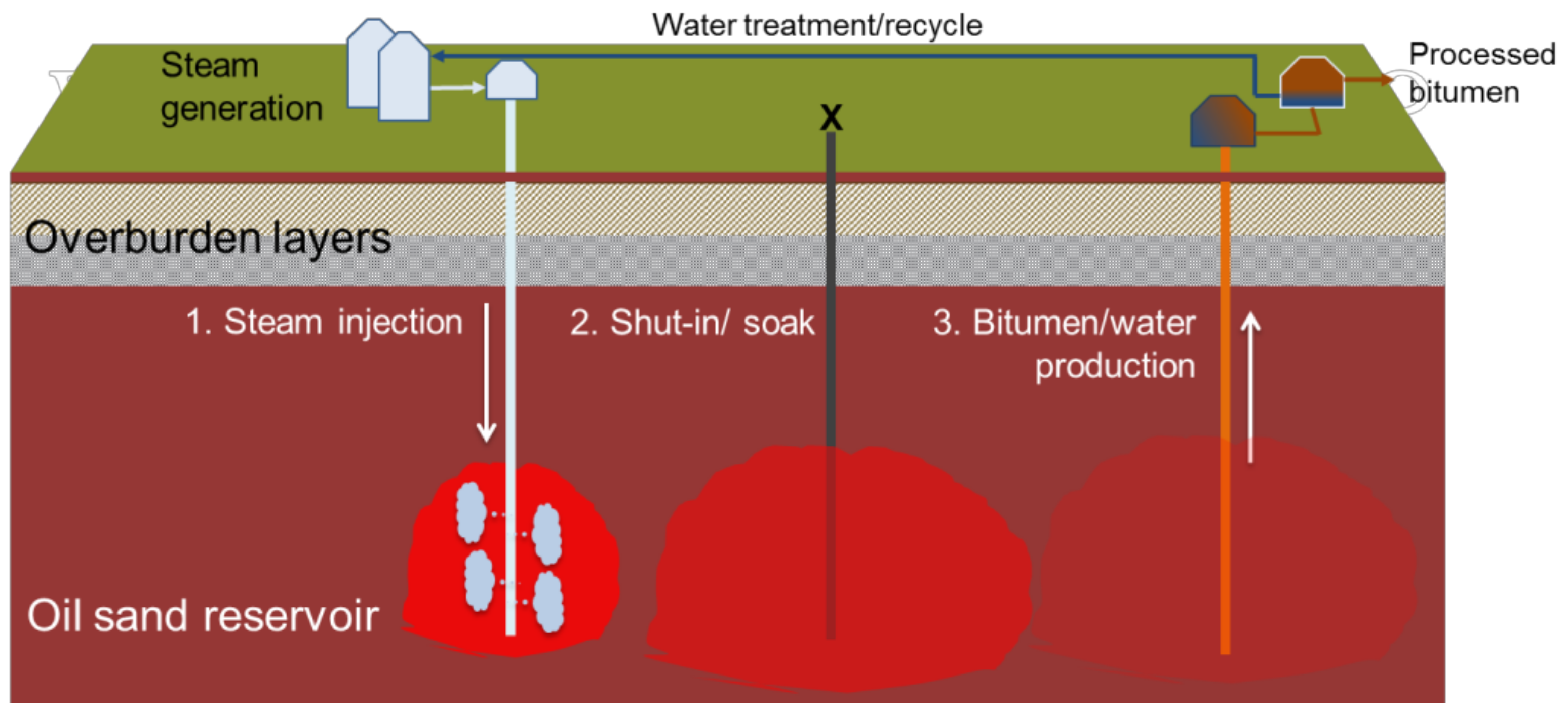

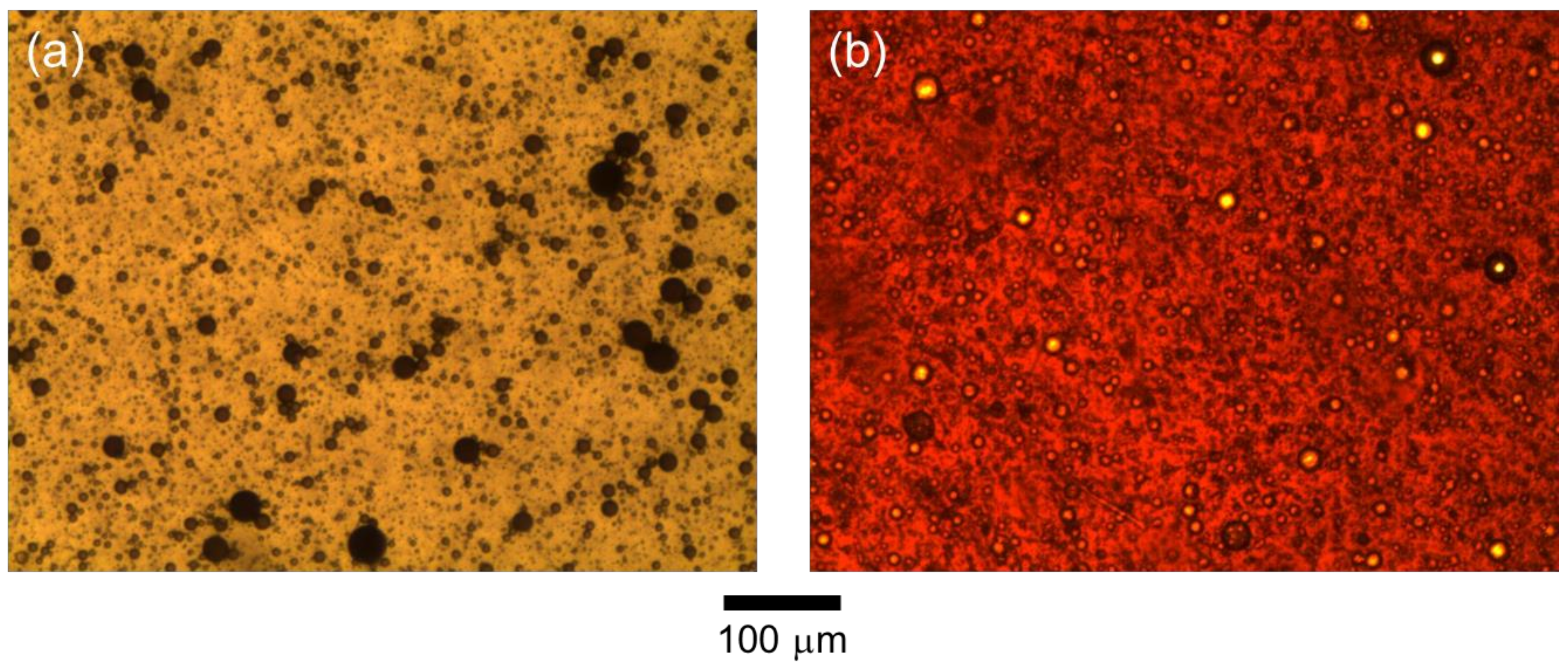
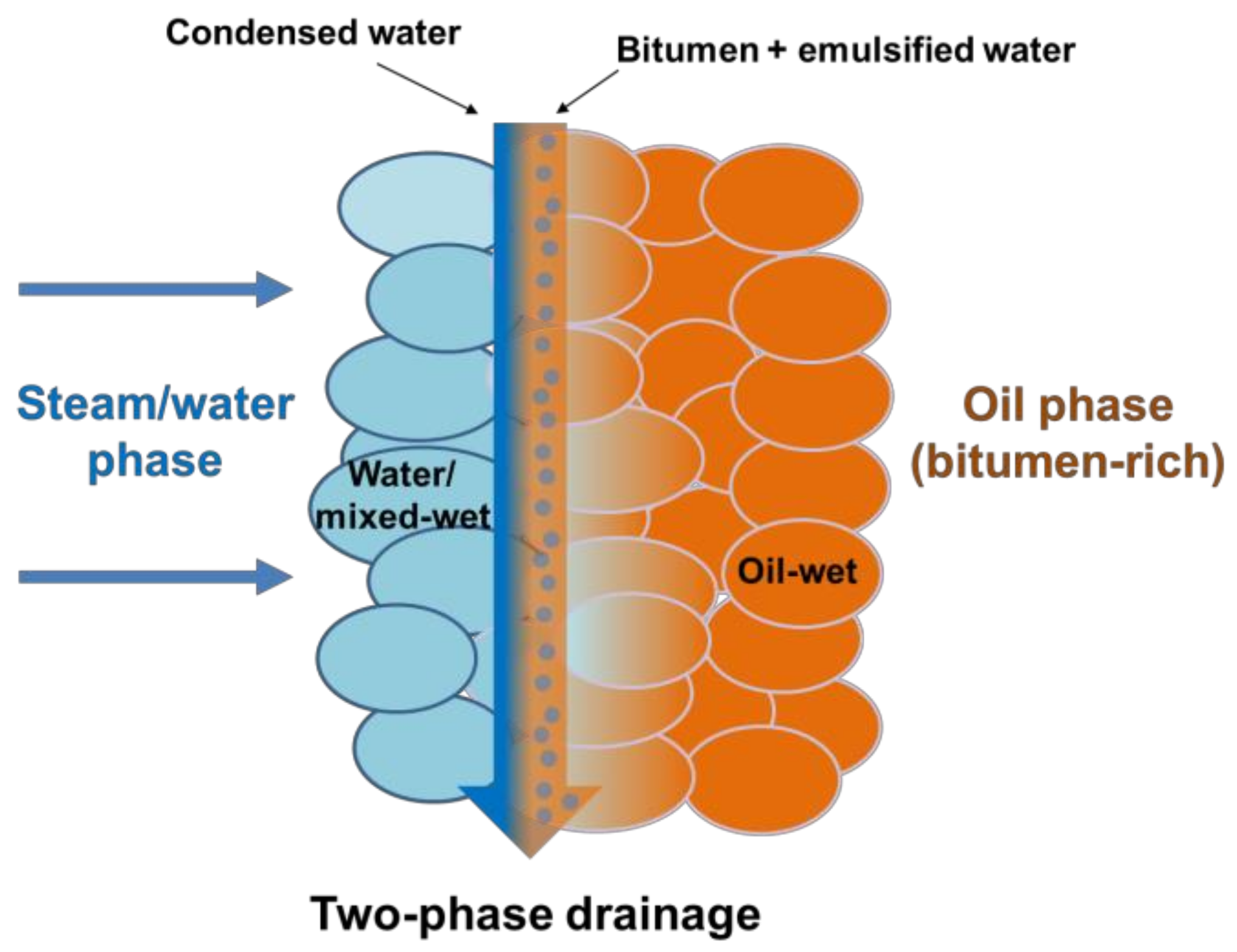
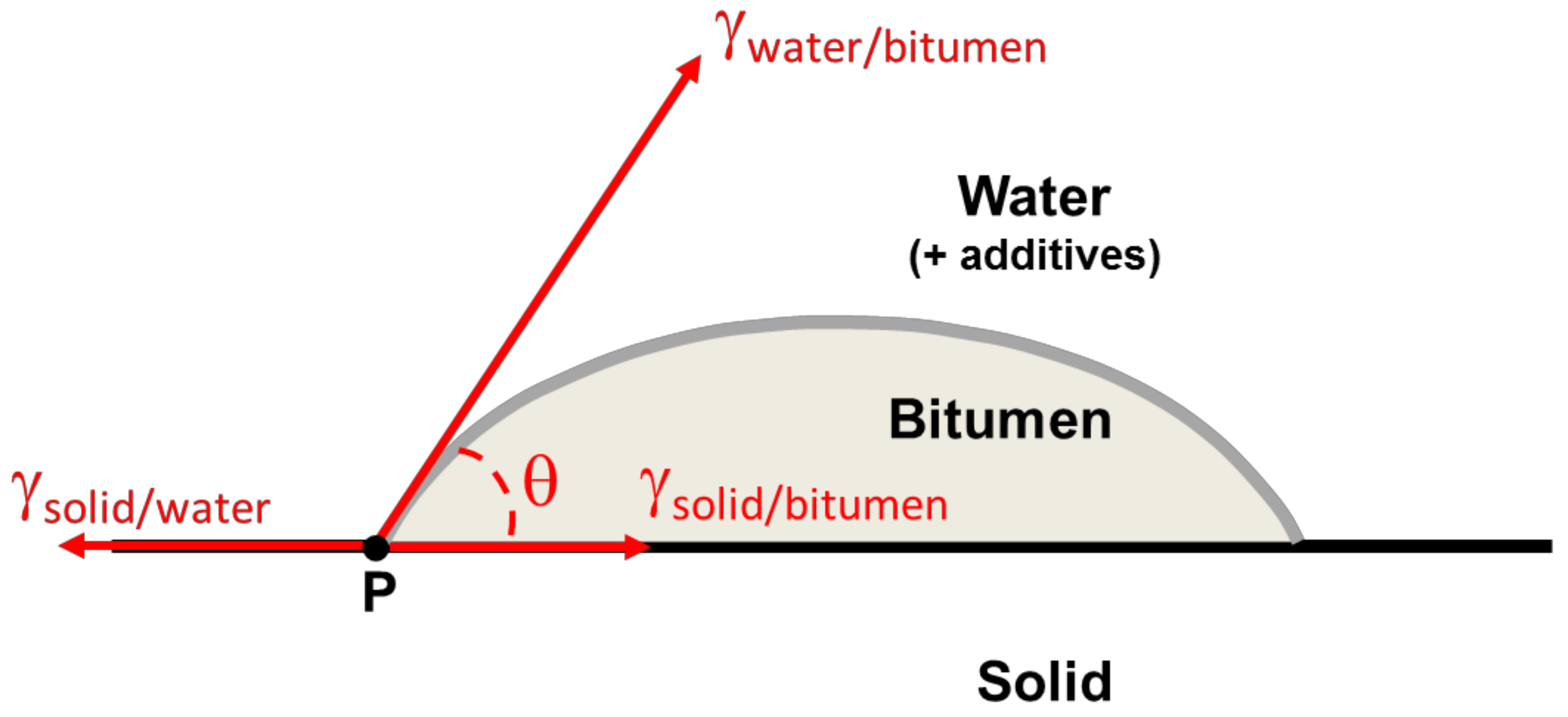

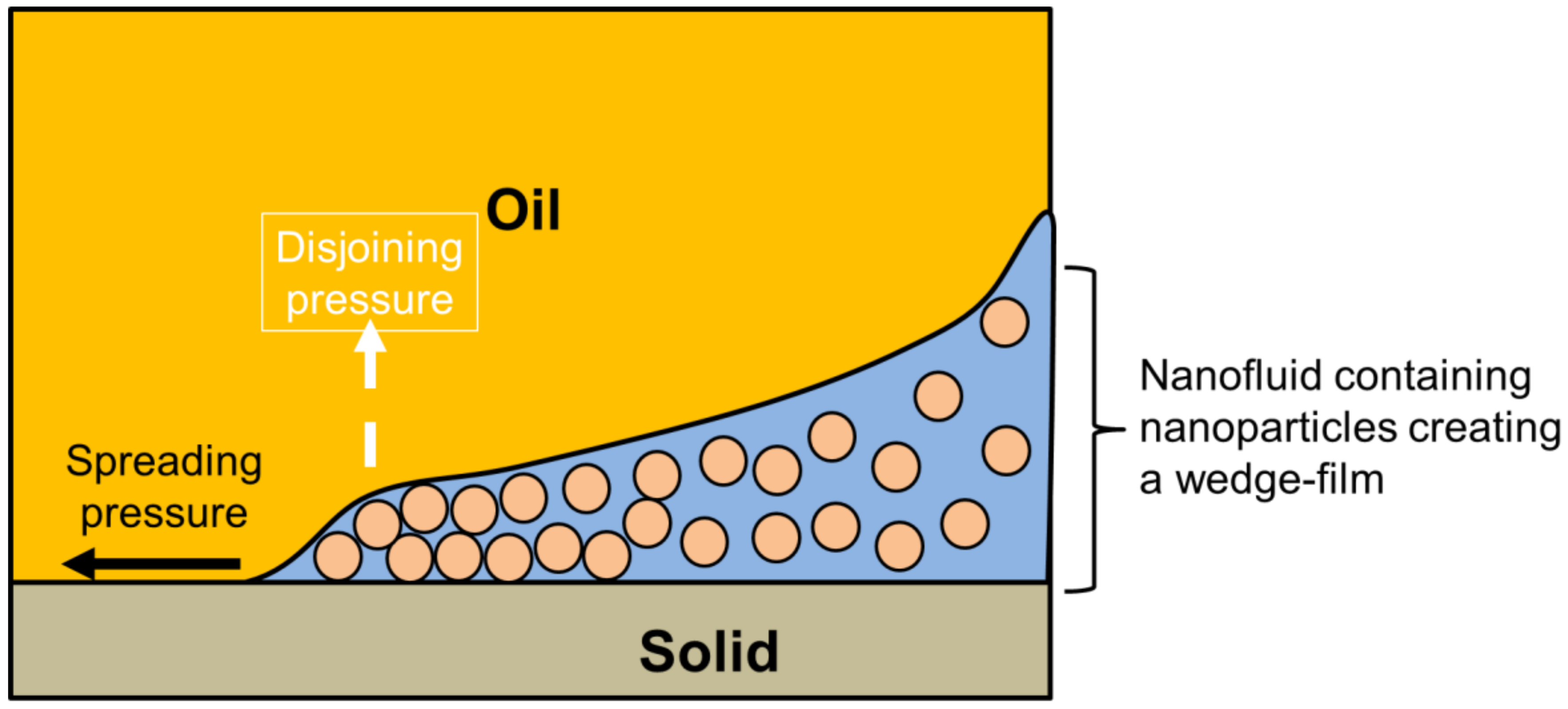


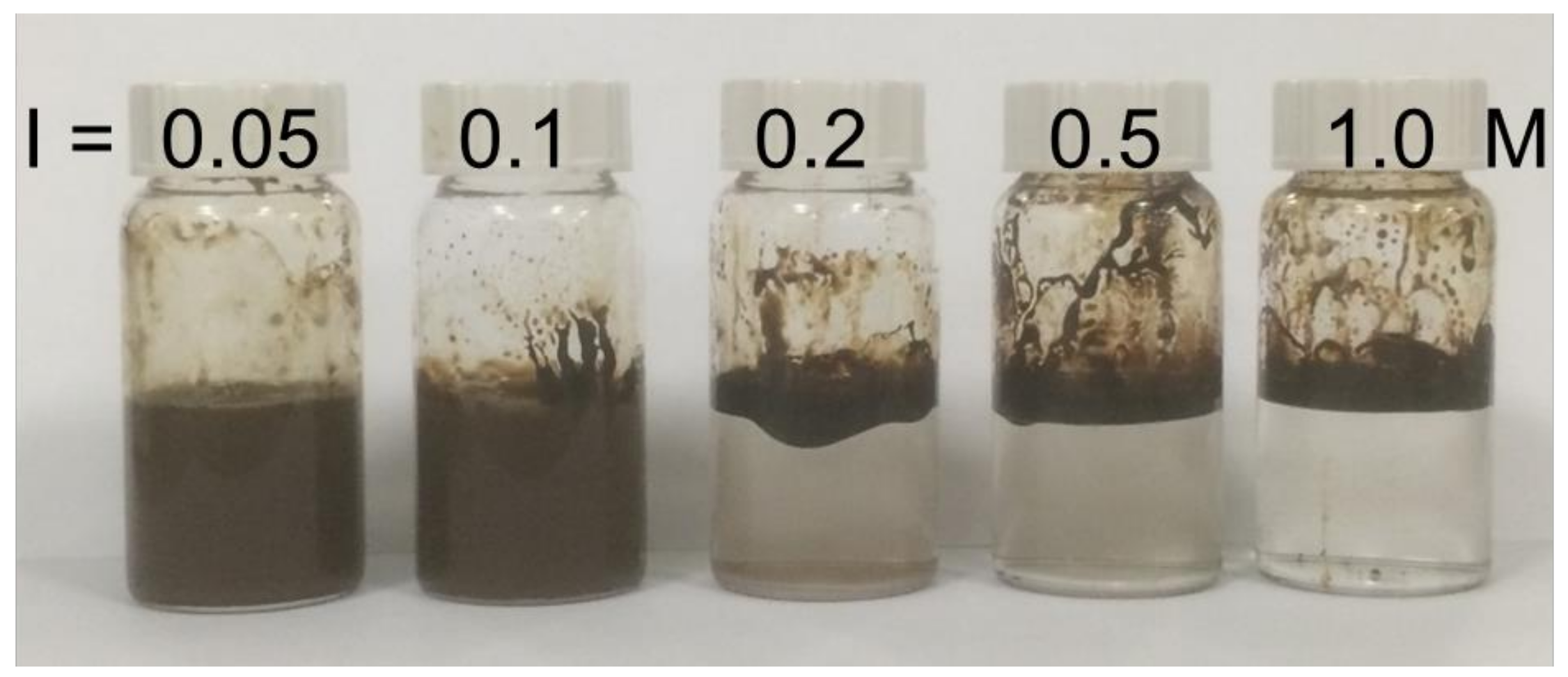
| Additive Type | Mechanisms |
|---|---|
| Solvents | Dissolution of oil; viscosity reduction |
| Alkaline agents | Interfacial tension reduction by activating indigenous surface active oil components; displacement and emulsification of oil droplets |
| Surfactants | Foaming—steam (and non-condensable gas) mobility control Interfacial tension reduction—oil displacement by surface dewetting, followed by emulsification of oil droplets Oil displacement by microemulsion formation Oil displacement by thin-film spreading agents Demulsification of w/o emulsions |
| Nanoparticles | Enhanced spreading and wettability modification Interfacial tension reduction Oil upgrading (catalytic nanoparticles) leading to viscosity reduction |
© 2018 by the author. Licensee MDPI, Basel, Switzerland. This article is an open access article distributed under the terms and conditions of the Creative Commons Attribution (CC BY) license (http://creativecommons.org/licenses/by/4.0/).
Share and Cite
Taylor, S.E. Interfacial Chemistry in Steam-Based Thermal Recovery of Oil Sands Bitumen with Emphasis on Steam-Assisted Gravity Drainage and the Role of Chemical Additives. Colloids Interfaces 2018, 2, 16. https://doi.org/10.3390/colloids2020016
Taylor SE. Interfacial Chemistry in Steam-Based Thermal Recovery of Oil Sands Bitumen with Emphasis on Steam-Assisted Gravity Drainage and the Role of Chemical Additives. Colloids and Interfaces. 2018; 2(2):16. https://doi.org/10.3390/colloids2020016
Chicago/Turabian StyleTaylor, Spencer E. 2018. "Interfacial Chemistry in Steam-Based Thermal Recovery of Oil Sands Bitumen with Emphasis on Steam-Assisted Gravity Drainage and the Role of Chemical Additives" Colloids and Interfaces 2, no. 2: 16. https://doi.org/10.3390/colloids2020016
APA StyleTaylor, S. E. (2018). Interfacial Chemistry in Steam-Based Thermal Recovery of Oil Sands Bitumen with Emphasis on Steam-Assisted Gravity Drainage and the Role of Chemical Additives. Colloids and Interfaces, 2(2), 16. https://doi.org/10.3390/colloids2020016




